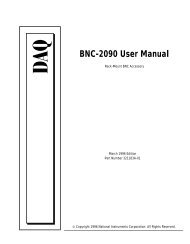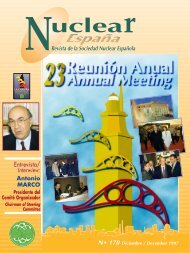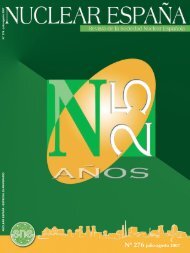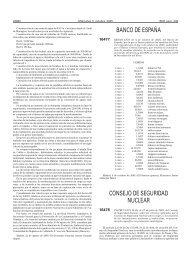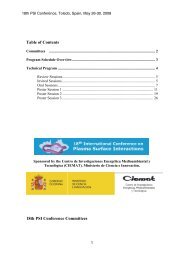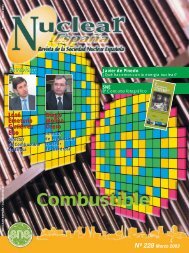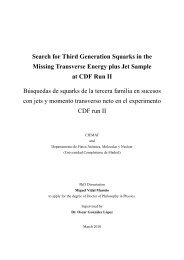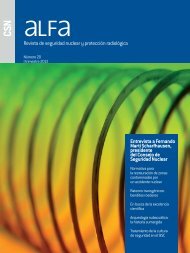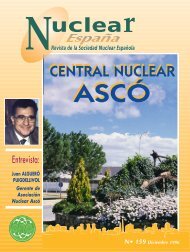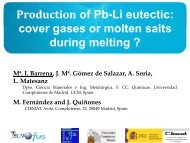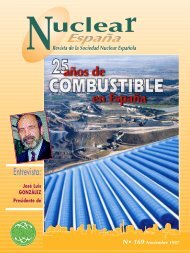EntrEntr evista/evista/ InterInter viewview
EntrEntr evista/evista/ InterInter viewview
EntrEntr evista/evista/ InterInter viewview
Create successful ePaper yourself
Turn your PDF publications into a flip-book with our unique Google optimized e-Paper software.
Remaining Lifetime, a Remotely Operated Robot<br />
System and CAMP.<br />
• Development of courses on medical practices<br />
for the treatment of the potentially irradiated and<br />
contaminated wounded, study of occupational<br />
accident rates at nuclear power plants and<br />
acquisition and dispatch of dosimetric and medical<br />
data for the epidemiological study at nuclear<br />
installations being performed by the International<br />
Cancer Institute (IARC) of Lyon (France).<br />
• Participation in a project on nuclear power plant<br />
lifetime management, along with EDF, Tractebel and<br />
Framatome, financed by the European Commission.<br />
• Drawing up, with ENRESA, of Appendix J of the<br />
UNESA-ENRESA Framework Contract for the<br />
management of radioactive wastes, on the<br />
dismantling of nuclear power plants.<br />
Finally, I cannot but dedicate a few words to the<br />
activities carried out from the UNESA nuclear area in<br />
relation to the so-called Y2K Effect. The<br />
coordination of work and activities (joint plans,<br />
common database, procedures, etc.) with the plants,<br />
the CSN and the Ministry of Industry and Energy’s<br />
Electricity Committee for the Y2K Effect has made it<br />
possible for the operation of Spain’s nuclear power<br />
plants, and of all the other electricity generating<br />
facilities, to continue with absolute normality as the<br />
transition to the year 2000 took place.<br />
It should be pointed out that, in accordance with<br />
the directives issued by the Ministry of Industry and<br />
Energy, and on the basis of the contingency plans<br />
drawn up, the plants reduced their power to 60% in<br />
order to minimise the effects that the hypothetical<br />
shutdown of a high capacity unit might have on<br />
national electricity supply during the transition to the<br />
year 2000.<br />
Like the rest of the Spanish electricity sector, the<br />
nuclear power plants operated throughout the<br />
aforementioned period of transition just like on any<br />
other day of the year. Safety, in particular, was<br />
maintained at the same high levels as is habitual,<br />
with the systems and components performing with<br />
absolute normality.<br />
THE PERFORMANCE OF THE ELECTRICITY<br />
INDUSTRY WITHIN A LIBERALISED<br />
FRAMEWORK<br />
I should now like to say a few words regarding<br />
some of the most significant aspects of the Electricity<br />
Industry throughout 1999.<br />
Progress in the process of liberalisation<br />
The process of opening of the market has once<br />
again been speeded up in 1999, with respect to what<br />
is established in Law 54/1997. The approval of<br />
Royal Decree Law 6/1999, of 16th April, regarding<br />
Urgent Measures for Liberalisation and Increasing<br />
Competition, has not only meant an additional<br />
reduction in the electricity tariff, to which I shall<br />
refer below, but also strengthening of the process of<br />
liberalisation. The percentage of participation on the<br />
organised generation market by eligible consumers<br />
has increased throughout the year, reaching around<br />
22% at year’s end. These consumers, who access<br />
the market directly or through commercialisation<br />
agents for their energy purchases, have benefited<br />
from an average price reduction of approximately<br />
20%.<br />
Furthermore, in accordance with the<br />
aforementioned Royal Decree Law, as from 1st July<br />
2000, all those having supplies at nominal voltages of<br />
more than 1,000 volts will be considered as qualified<br />
electricity consumers, this meaning some 65,000<br />
clients representing around 54% of the market.<br />
• Gestión de más de 30 proyectos<br />
del Plan Coordinado de<br />
Investigación CSN-UNESA, cuyo<br />
importe conjunto es de cerca de<br />
800 MPta, habiendo finalizado 10<br />
de ellos en 1999 y aplicado 205<br />
MPta. Asimismo, se han continuado<br />
los trabajos de los proyectos PIE sobre<br />
Vida Remanente, Sistema<br />
Robótico Teleoperado y CAMP.<br />
• Desarrollo de cursos de prácticas<br />
médicas para el tratamiento de<br />
potenciales heridos irradiados y<br />
contaminados, estudio de la accidentabilidad<br />
laboral en las centrales<br />
nucleares y obtención y envío de<br />
datos dosimétricos y médicos para<br />
el estudio epidemiológico en instalaciones<br />
nucleares, que realiza el<br />
Instituto Internacional del Cáncer<br />
(IARC) de Lyon (Francia).<br />
• Participación en un proyecto<br />
sobre gestión de vida de centrales<br />
nucleares junto con EDF, Tractebel y<br />
Framatome, financiado por la<br />
Comisión Europea.<br />
• Redacción con ENRESA del<br />
Apéndice J, sobre desmantelamiento<br />
de centrales nucleares, del<br />
Contrato-Tipo UNESA-ENRESA para<br />
la gestión de residuos radiactivos.<br />
Por último, no puedo por menos<br />
que dedicar unas palabras a las actividades<br />
que desde el área nuclear<br />
de UNESA se han venido dedicando<br />
al denominado Efecto 2000. La coordinación<br />
de los trabajos y actuaciones<br />
(Planes conjuntos, base de<br />
datos común, procedimientos, etc)<br />
con las centrales, el CSN y el<br />
Comité Eléctrico del MINER para el<br />
Efecto 2000 ha posibilitado que el<br />
funcionamiento de las centrales nucleares<br />
españolas, al igual que el<br />
resto de las instalaciones de generación<br />
eléctrica, haya sido absolutamente<br />
normal en el tránsito al año<br />
2000.<br />
Es de señalar que, de acuerdo con<br />
las directrices dadas por el<br />
Ministerio de Industria y Energía en<br />
base a los planes de contingencia<br />
previstos, las centrales redujeron su<br />
potencia al 60% con el fin de minimizar<br />
los efectos que pudiera tener<br />
sobre el suministro eléctrico nacional,<br />
una hipotética parada de un<br />
grupo de alta capacidad de generación.<br />
Al igual que el resto del sector<br />
eléctrico español, las centrales nucleares<br />
funcionaron en dicho tránsito<br />
como cualquier otro día del año.<br />
En particular, la seguridad se mantuvo<br />
en los mismos altos niveles que<br />
vienen siendo habituales, con un<br />
comportamiento absolutamente normal<br />
de sus sistemas y componentes.<br />
EL COMPORTAMIENTO DEL<br />
SECTOR ELƒCTRICO EN UN<br />
MARCO LIBERALIZADO<br />
Llegados a este punto, permítanme<br />
decirles unas palabras sobre algunos<br />
otros aspectos significativos<br />
del Sector Eléctrico en 1999.<br />
A b r i l 2 0 0 0<br />
R e v i s t a S N E




